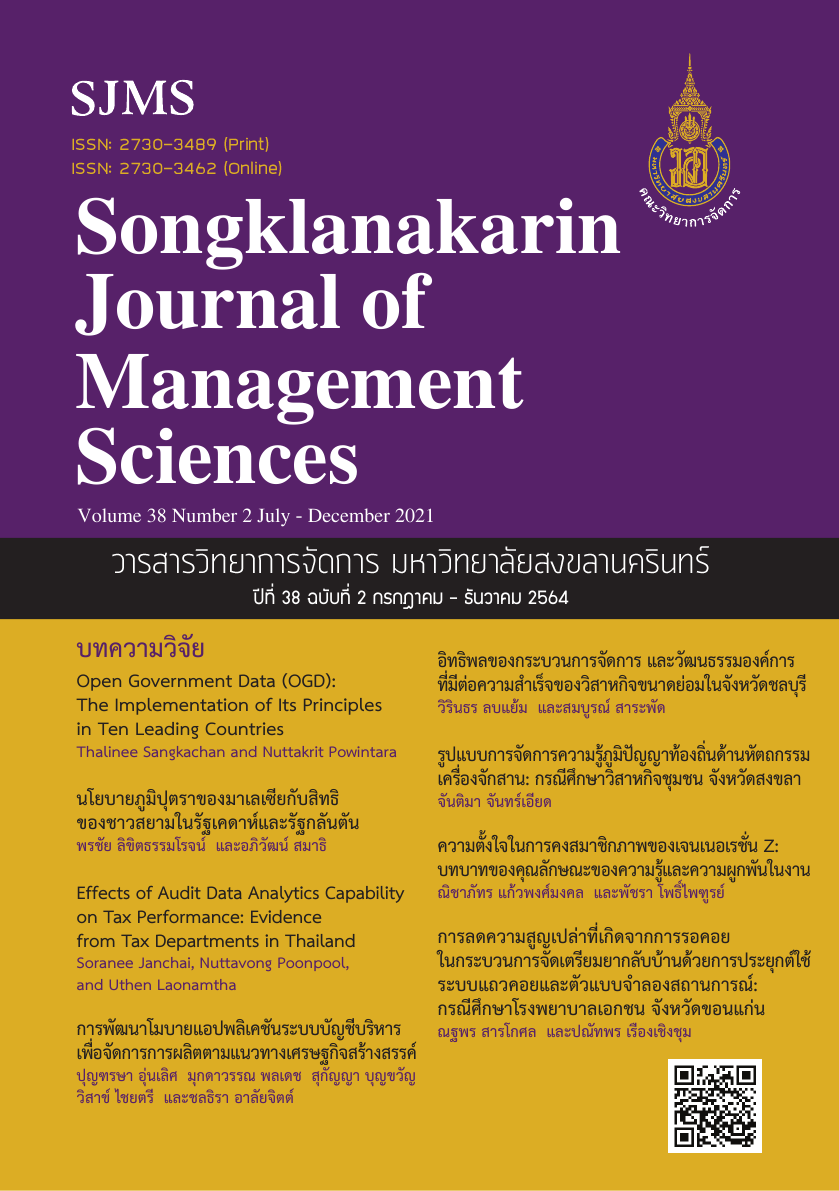Malaysia’s Bumiputera Policy and the Rights of Siamese People in Kedah and Kelantan
Main Article Content
Abstract
This research aimed to study the rights of Siamese people on Bumiputera policy in Kedah and Kelantan; to study the advantages and disadvantages of the Bumiputera policy, and the guidelines for the management of Siamese people rights according to the Bumiputera policy. This research was qualitative research. The key informants consisted of 18 community leaders, religious leaders, special official of state executive, and the Siamese people who had knowledge about Bumiputera policy in Kedah and Kelantan States by purposive sampling and in-depth interview. The data was analyzed by descriptive analysis. Result of the study revealed that the rights of the Siamese people in Kedah and Kelantan according to the Bumiputera policy in many aspects. Economic aspect (the rights to purchase of stocks in ASB funds and Bank Rakyat, trading). Social aspect (the rights in medical care, religious affiliation). Political aspect (the right to be senators, political party members, village headmen).The advantages of the Bumiputera policy were as follows:-the Siamese had opportunity to serve civil service, received a 10% quota of education for non-Malay children.The disadvantage of Bumiputera policy was that the Siamese people still did not have the rights or opportunities as equal as the Malay people.The guidelines for the management Bumiputera policy toward Siamese people were as follows. Politicians should amend laws and regulations in order to give the rights to Siamese people equally with the Malay people gradually and it would be beneficial to the Malaysian government in reviewing the Bumiputerra policy toward Siamese people. This suggestion created a new body of knowledge and inspired other researchers to study more Siamese in Malaysia.
Article Details

This work is licensed under a Creative Commons Attribution-NonCommercial-NoDerivatives 4.0 International License.
All published articles are SJMS’s copyright. The editorial board allows all published articles to be copied, excerpted, or disseminated with academic citation.
References
Aryuwatthana, T. (2004). Thai in Malaysia. Bangkok: Buddha Press.
Attorney of Malaysia. (2020). Federal Constitution, 1957. Retrieved June 26, 2020 from www.agc.gov.my
Bunmak, S. (2013). Thai Restaurants in Australia: The Reflection of “Thai-ness” and “Adaption”. Journal of Liberal Arts, Prince of Songkla University, 5(1), 90-103.
Chantavanich, S. (2016). Methods of Qualitative Research. (23th ed.). Bangkok: Chulalongkorn University Press.
Chuenglertsiri, P. (2018). Equality in Inequality: The Life of Thai Housewives in the UK. Retrieved August 26, 2020 from https://www.the101.world/a-life-of-thai-housewife-in-great-britain/
Chotisut, C. (2014). Bumiputera: Racial Policies in Malaysia. Parichart Journal, 27(1), 78-97.
Duangchan, P. (2008). Social Process for Thai Maintaining and Inheriting of Thai People Living in the Northern State of Malaysia. Songkhla: Thaksin University.
Jullasap, S. & Nooaim, B. (2020). The Siamese in Perlis Malaysia : Background Status and Maintaining. Journal of MCU Nakhondhat, 6(10), 6094-6107.
Julsiriwong, C. (1999). Economic and Political Development Malaysia. Bangkok: Kobfai.
Meesantan, C. (2018). Temples and the Existence of Thainess Through the Siamese in the State of Perlis and Kedah, Malaysia. NIDA Development Journal, 15(2), 169-205.
Mohamed Yusoff Ismail. (1993). Buddhism Ethnicity : Social Organization of a Buddhism Temples in Kelantan. Singapore: Institute of Southeast Asian Studies.
Nakseethong, P. & Puttichot, A. (2009). Thai People in Kedah : A Study of Thai’s Existence in History (1909 - 2007). Bangkok: The Thailand Research Fund.
Promsaka Na Sakolnakorn, T. (2018). Conflict Management and Peace Process in ASEAN. Bangkok: O.S. Printing House.
Ruenkaew, P. (2015). Research Project to Gather Basic Information about Thai people and community formation in Singapore, Malaysia, Vietnam, Taiwan, and Japan. Bangkok: The Thailand Research Fund.
Ruengnarong, P. (1988). The Study of Thai communities in Kedah. Pattani: Prince of Songkla University.
Thaweesit, S., Sunpuwan, M., & Chuanwan, S. (2013). Population and Society in ASEAN : Challenges and Opportunities. Bangkok: Octoberprint.
Thianthong, D., Tangtrongpairoj, S., Aree, S. & Baru, W. (2008). The Comparative Policies of Management toward the Problem of Minorities of Muslim Countries in Asia : Case Study Malaysia, Indonesia, and Turkey. Bangkok: Muslim Studies Center, Institute of Asian Studies, Chulalongkorn University.
Thongjiaw, W., & Thongjiaw, A. (2013). ASEAN History. Bangkok: Saengdao Press.
Tipsrinimit, N. (2011). The Cultural Identities of the Thai People in the Northern States of Malaysia. (Doctor of Philosophy). Mahasarakham University.
Tulyasak, A. (2014). Social and Ethnic Inequality in Malaysia (A Case Study of Bumiputera Policy with Chinese People). Prachatai. Retrieved June 26, 2020 from https://prachatai.com/journal/2014/05/53364
Wikipedia. (2020). Malaysian Siamese. Retrieved June 26, 2020 from http://th.wikipedia.org/wiki/Malaysian_Siamese
Winzeler, R. L. (1985). Ethnic Relation in Kelantan : A Study of the Chinese and Thai as Ethnic Minorities in a Malay State. Singapore: Oxford University Press.

